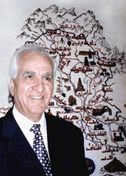The Hadj and the 21st century
The Hadj is probably one of God's miracles. Since the beginning of human history God called on Ibraham: "Behold! We gave the site, to Abraham on account of journeys through deep and distant mountain highways;” (The pilgrimage - al Hadj 26&27)
Year, after year, and century after century, this call spreads fast among millions of Moslems in the four corners of the world. This miracle, constantly renovated, is the symbol of all noble human values of equality and love.
Our entry to the 21st century, the development of the sciences and technology and the new life styles of humanity makes it incumbent on the Moslems, to be the vanguard of civilization this century. This is our duty because of our faith and the clarity of vision of our humanitarian role. God put these sciences at the disposal of all humanity, not a particular people, since he said: " (He) taught man that which he knew not” (al-Alaq /5).
The centres of research, development and production don't limit themselves to a particular race. They are managed by people of different nationalities. History teaches us how the liberal arts had been transmitted throughout generations and civilizations with considerable difficulty. Today, thanks to the evolution of the brain with which God endowed man, there is no longer any hindrance to the transmission of the sciences. Several people in different countries have even come to the same conclusions in pursuit of the same goal.
That is why we would like to have a Hadj that is a spiritual miracle and a miracle worthy of 21st century civilization, to become a model of our religious tourism: umrahs, visits to the holy places, festivals and religious occasions.
I was encouraged to take an interest in this topic due to the evolution and expansion of the holy mosques of Mecca and Madina and the need to use sciences, technology and modern innovations for easing the performance of Hadj rituals, with a guarantee of pilgrims' security and a healthy environment in the holy places.
During my Hadj this year, I noted the following:
1 - The Kingdom of Saudi Arabia extended the Prophet's Mosque and Kaaba using the most advanced construction technology, lighting, distribution of sound and air-conditioning. Thus, while entering these holy places to pray, the pilgrims feel serene, happy and proud.
2 - Similarly, the Kingdom solved the problems of the big influxes at the time of the throws of the Jumars, the scene of many accidents and disasters, by extending the space reserved for the throw. They integrated the three places of 2 m² each in a defensive wall more than 20m wide. This was welcomed favorably by all religious scholars.
3 – There are other services that the Saudi Kingdom provided for the pilgrims, such as security, medical aid, free drinking water, bags of free food offered by the King in Mecca and also by the Prince of Madina. Some Saudi societies also distributed food and drinks.
4 - The cordial welcome extended to the pilgrims at the airports by officials who have the responsibility to manage and facilitate their movement and not to intervene in the performance of the rituals, as was previously the case. This is a positive development.
What is to be done?
The Kingdom of Saudi Arabia is called upon to comply with three demands:
1. To lay down the rules and regulations and enforce them when pilgrims perform the hadj rituals.
2. To ensure the cleanliness of the boulevards and streets frequented by pilgrims.
3. To prevent air pollution from motor vehicles.
The problem of over-crowding
1) It is essential to put walk lines appropriate to the number of the visited places to control the circulation of the pilgrims towards the place of throw, as well as towards the boulevards of entry and exit from Mina.
2) To allocate a place for the street sellers and not tolerate their presence in the paths of the pilgrims, as this hinders the performance of the hadj rituals.
3) a. Spending the night at Mina is determined legally and officially. It is necessary to find a solution to the problem of excess as three million pilgrims must perform this ritual.
b. Many pilgrims go and come to Mina, preventing other pilgrims from performing their rituals and and causing problems of over-crowding.
c. Many theologians call on the pilgrims to spend part of the night at Mina in order to alleviate the over-crowding. How they come and go from the city must then be regulated. The solution would be to ensure that the ritual of spending the night in Mina is as indicated above ©, is agreed on by Moslem scholars. In this case, the solution would be to empty Mina of its night and day residents during the days of the throw of the jumar and regulate arrivals and departures according to the legal timetable.
Excess to Mecca
The extensions in Mecca can be made by adding other levels for prayers and for the Tawaf around the Kaaba. Other exits should be made to these floors, or access can be obtained through mobile stairs like the ones used in international airports. Independent exits are required or provisions have to be made for the pilgrims to come and go with the assistance of guides. As for the excess at the time of the Tawaf around the Kaaba, I propose to widen the circle of Tawaf and to make an entry and an exit there, if it is possible and permissible by the Sharia.
Excess to the Prophet's Mosque
It is necessary to solve the problem of excess in this blessed space. However, in all fairness, it is necessary to organize the access to this place in order to allow every pilgrim to pray there. It is necessary to put about twenty passages in place with entrances and exits and to fix a time for prayer, five minutes for example, for each pilgrim.
Rubbish
It is obvious that rubbish is left in the Holy Places because of carelessness and a lack of respect for Islamic values, since according to the Prophet's Hadith cleanliness is part of faith. Despite all the signs urging the pilgrims to put their rubbish in litter bins, not everyone complies with this request. There are two solutions: one scientific and technological and the other educational and civilisational. The first solution, concerns the road of Mina, Arafat, Mozdalifa and Madina, where subterranean conveyor belts with openings for disposing of rubbish can be installed. These are transported to other places, where they will be sorted and re-used.
Purification of air
One notices many panels inviting the pilgrims to seize the opportunity of their presence in the cities of Madina and Mecca and their climate of devotion to stop smoking. On the other hand, one notes that the hadj rituals take place in an environment polluted by gasses from vehicles, due to the density of the road traffic and traffic jams that characterize these cities, exposing the pilgrims to many illnesses.
This can be solved by:
a. Establishing a line of electric trams (non covered) between Mecca, Arafat, Mozdalifa, Mina, replacing the vehicles using fuel,
b. Using automatic electric buses.
c. Using conveyor belts, as in airports, for the small distances of Hadj
d. Encouraging walking and transport of pilgrims on automatic lines or carriages.
The educational role
How can we ensure pilgrims will keep to the rules? This is a big issue which involves the educational factor. Saudi Arabia must produce a film and a booklet in several languages demonstrating the inconvenience of over crowding and the lack of respect for cleanliness, as well as the need for pilgrims to respect security and cleanliness. These films must be sent to all Saudi embassies and their representatives authorised to issue visas, so they can be shown to visa applicants who will have to sign a pledge to abide by the regulations before receiving their visas. All Hadj tour operators must also undertake to make pilgrims aware of the rules. Theologians and preachers throughout the world can also intervene and educate worshippers about the principles of Islam regarding cleanliness, respect for others and behaviour which does not inconvenience fellow worshippers (raised voices, cigarettes etc…).
Final observation
The Kingdom of Saudi Arabia certainly has ambitious programs to develop Hadj, Umrah and religious tourism in future. Indications of this development impetus are obvious in the government's and peoples' orientation due to the importance of tourism - especially religious tourism: the investment is guaranteed and there is no competition. Saudi Arabia and its technological and industrial establishments have demonstrated expertise at the level of architecture, and the scope of their industrial and infrastructural projects.
If one looks at the Olympics, one is astonished by the preparations and the massive investments in several countries hoping to have the opportunity to host these games; they spend millions of dollars on building the infrastructures for a one off event lasting only a few weeks.
However, Hadj is an event that occurs again and again every year in the same place. Hence the investment in this domain of tourism in Saudi Arabia can only be greatly profitable.
We hope that the responsible persons of this country welcome our article favorably and that Hadj and Umrah are examples to be followed in all our religious festivities.
May God guides us to success.
|

